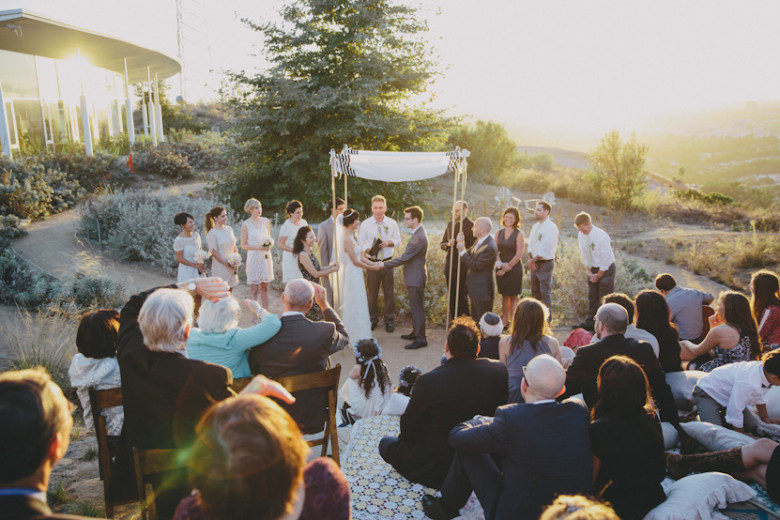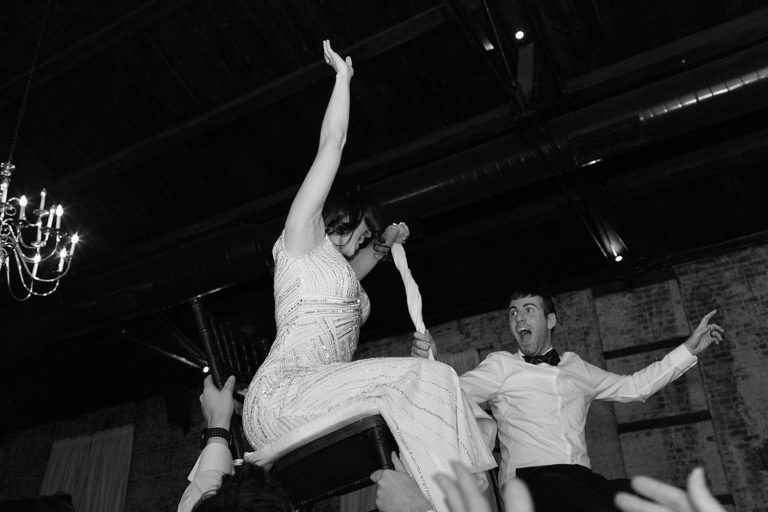 If you’ve been to more than one Jewish wedding, you’ve probably noticed some huge differences in traditional Jewish rituals from wedding to wedding. (And if you haven’t been to a Jewish wedding yet, I hope you’ll get a chance. They are great!) Why is that? I mean, isn’t the point of a wedding ritual to provide a single, “by the book” structure everyone could follow? Well, kind of. But in Jewish weddings it’s a bit more complicated than that.
If you’ve been to more than one Jewish wedding, you’ve probably noticed some huge differences in traditional Jewish rituals from wedding to wedding. (And if you haven’t been to a Jewish wedding yet, I hope you’ll get a chance. They are great!) Why is that? I mean, isn’t the point of a wedding ritual to provide a single, “by the book” structure everyone could follow? Well, kind of. But in Jewish weddings it’s a bit more complicated than that.
Making it Modern
These days, many Jewish couples (including APW founder Meg and her husband David) use the traditional Jewish rituals as a base structure, and then make modifications to fit their own needs and religious practices. While many traditional Jewish customs have stood the test of time and are still widely used in most Jewish weddings, some traditions are pretty significantly altered, and some are even outright ignored.
For example, most of the traditional Jewish customs, like the Chuppah (wedding canopy), Ketubah (Jewish marriage contract), and glass breaking still exist, and they probably won’t go anywhere anytime soon—or ever. But modifications of these and other traditions have been made over the years (mostly in reform weddings) to make them more relevant to modern times.
So let’s break down what you’ll most likely run into at a modern Jewish wedding.
Jewish Wedding Traditions
Fasting
Yes, some Jews choose to fast on their wedding day. Kinda weird, isn’t it? I know what you’re thinking: “Isn’t it supposed to be a happy day? What gives?”
Actually, that’s exactly why this tradition exists in the first place. According to Jewish tradition, fasting enhances the importance and spirituality of this special day. It highlights the transition taking place in the couple’s lives. Plus, the Jewish wedding day is considered a day of forgiveness, just like Yom Kippur—the Jewish day of atonement—and we fast on Yom Kippur.
Although not mandatory, this custom has become increasingly popular.
The (Pre) Wedding Reception
At the reception before the service, you are greeted by the couple’s family, hand over your wedding gift (if you’re looking for some ideas for specifically Jewish wedding gifts, here is your roundup), and smile at the camera for the first time. Most importantly, it’s the first time during the evening you’ll get to enjoy some tasty snacks and drinks to warm up your stomach before the main event starts. The greetings, the mingling, and the tasty cocktails are the perfect transition to the most emotional part of the wedding—the wedding ceremony. (Note: Not all Jewish weddings have a reception before the service, but the more Orthodox the wedding, the more likely you’ll get a drink before the Chuppah.)
Badeken
The Badeken is the veiling of the bride (coming from the Yiddish word, “to cover”) that is most often seen in more traditional Jewish weddings, though it is sometimes modified to be included in a more egalitarian fashion in modern or reform weddings.
This is where, traditionally, the groom looks at the bride and places her veil over her. This act has biblical roots in the story of Jacob being tricked into marrying Leah, instead of Rachel, his beloved. The veiling is said to symbolize the choice of a partner based on inner beauty, not just external beauty. Another Jewish tradition says that when a bride’s veil covers her face, all of her future descendants walk with her.
 Photo by Mandee Johnson via A Practical Wedding
Photo by Mandee Johnson via A Practical Wedding
The Jewish Wedding Ceremony
The wedding ceremony takes place under the Chuppah—the Jewish wedding canopy.
Did you know? While the literal meaning of “Chuppah” refers to the Jewish wedding canopy, many people started using the term interchangeably to describe the wedding ceremony itself.
The traditional Chuppah was made up by a cloth or Jewish Tallit covering the couple, but these days it has become popular to design or choose a personalized Chuppah.
Usually, the couple’s family members form the wedding canopy’s walls, symbolizing the love and warmth the couple is surrounded with.
The ceremony starts when the first partner enters escorted by their parents (or both partners’ fathers) to the Chuppah, followed by the second partner who’s also escorted by their parents (or both partners’ mothers). The escorting arrangement may vary depending on family situations—divorces, single parents, etc.
The couple meets halfway down the aisle and walks together to the Chuppah, after which seven circles are performed. Traditionally the bride circled the groom seven times, to represent creation. But in many more egalitarian services, modified versions of the circling tradition have emerged: some couples choose to circle each other three times and circle once together. There aren’t any hard rules, so the couple usually decides what works for them.
Did you know? The number seven is the most sacred number in Judaism. It represents creation, wholeness, and purity (seven days of creation, seven branches of the Jewish Menorah…).
At this point, the Rabbi starts the ceremony.
Kiddushin (Blessings of Betrothal)
The Jewish wedding ceremony is divided into two parts: the Kiddushin and the Nisuin.
In the Kiddushin, the Rabbi recites the betrothal blessings, followed by the blessing over wine. The couple then recites the blessings, and they drink their first cup of wine.
Did you know? Wine plays a big role in Jewish tradition. It represents happiness in Jewish scriptures and is consumed during almost every Jewish special occasion, including celebrations, holidays, and the Sabbath.
Exchanging of Rings
Jewish wedding rings are supposed to be a solid unbroken band, representing eternity. Some couples do have fancier rings with stones, but they generally also have a simpler ring used as part of their religious ceremony. Traditionally, the groom was required to give a solid (usually gold) ring to the bride and recite the Jewish marriage blessing. These days, egalitarian Jewish couples use two rings, and both members of the couple participate in the ring exchange ceremony and recite the marriage blessing.
The Jewish Wedding Vows
The Jewish marriage blessing, often construed to be the wedding vows, translates to, “Behold, you are consecrated to me with this ring according to the laws of Moses and Israel.”
While other vows are not a formal requirement in a Jewish wedding, many modern couples choose to write and exchange their vows before or after the wedding ceremony. This practice has been adopted from other Western cultures and incorporated into Jewish weddings.
 Photo by Smitten Chickens Photography via A Practical Wedding
Photo by Smitten Chickens Photography via A Practical Wedding
The Ketubah
Before the ceremony begins, the families meet to read and sign the Ketubah—the Jewish marriage contract. After the rings are exchanged, the Rabbi reads the Ketubah.
The Ketubah is probably the single most modified Jewish wedding element. Originally written in Aramaic, it is focused on the husband’s responsibilities over his wife: to provide her with basic necessities such as food, clothing, and conjugal rights. It is considered to be one of the more forward-thinking and feminist documents of its day, because it mentions the husband’s requirement to compensate his wife financially in case the couple files for divorce.
Modern couples often modify Ketubah text from the traditional Aramaic document, so it reflects their understanding of the commitment they are making to each other. Contemporary common changes you’ll find include:
- Changing the Ketubah language from Aramaic to Hebrew, sometimes even English.
- Altering the one-sidedness, from the husband’s sole responsibility for his wife to the couple’s mutual responsibilities and obligations to each other.
- Adding or even rewriting the text, in order to add an emotional touch to the otherwise strictly legal document.
 Photo by Erica Camille via A Practical Wedding
Photo by Erica Camille via A Practical Wedding
Breaking the Glass
Concluding the wedding ceremony is what Jewish weddings are most known for—breaking the glass!
While in more traditional ceremonies, only the groom broke a glass, it’s common in more egalitarian ceremonies for both members of the couple to break a glass.
Some people think that breaking the glass is just a cool way of saying, “Let’s party.” But as with all Jewish wedding traditions, the symbolism is much deeper and richer than that. There are as many interpretations of a tradition as there are Jews, but the most common meanings behind the shattering glass are these:
- It represents the destruction of the Jewish temple and the fall of Jerusalem.
- The broken glass demonstrates the fragility of love. Like glass, a marriage needs to be protected to keep it whole.
- It demonstrates the couple’s dedication to Tikkun Olam (repairing the world), as a reminder that even in our happiest moments, we know that the world is a broken place, in need of our work to repair it.
Even in moments of great joy, it reminds us of the Jewish people’s painful path through history.
Seven Blessings
Now comes the second and arguably the main part of the ceremony—the Nisuin.
The Rabbi starts with a blessing over the second cup of wine, the first of the seven blessings.
The couple recites the seven blessings carried out by the Rabbi. The blessings refer to several themes, including:
- Gratitude for God’s creation
- Blessing the couple for a happy marriage
- The reconstruction of Jerusalem and the Jewish temple
Some couples choose to have their families included in the reading of the seven blessings. For example, the Rabbi would read the blessing in Hebrew, while a family member reads it in English. There are many forms of the seven blessings written in more egalitarian language for couples to choose from. Some couples choose to have family members write blessings for them and work with their Rabbi to create even more personal blessings.
 Photo by Jamie Street for Rad + In Love via A Practical Wedding
Photo by Jamie Street for Rad + In Love via A Practical Wedding
Yichud
Finally, a moment of privacy.
The Jewish tradition of Yichud (“seclusion” in Hebrew) gives the couple the chance to enjoy a few moments of privacy for the first time as husband and wife before all the partying begins.
That’s also when the couple usually grabs a bite to eat after (possibly) a long day of fasting. It’s a great chance for them to take a deep breath before they go out and enjoy the night they will never forget!
 Photo by City Love Photography via A Practical Wedding
Photo by City Love Photography via A Practical Wedding
The Feast (Party time!)
While technically this part is called Seudah, which means “feast” in Hebrew, what this actually means is… party time!
You can’t miss the Jewish dance styles and extreme joy flowing down the dance floor, usually before the alcohol even gets a chance to kick in. The Jewish circle dance (the Horah), the “train dance,” and of course lifting the bride and groom on chairs are just a few examples of what happens on the Jewish wedding dance floor.
These Jewish dance traditions are all designed to do one thing: to bring joy to the Jewish couple and place them at the center of the community (sometimes quite literally). In Jewish tradition, bringing joy to the couple on their wedding night is considered a mitzvah, which translates as a good deed, or even a religious commandment. Which means that celebrating the married couple on this day is your literal duty to God.
So, get out there and have a great time… that’s an order!
The post 12 Things You Need to Know before Attending a Jewish Wedding appeared first on A Practical Wedding: We’re Your Wedding Planner. Wedding Ideas for Brides, Bridesmaids, Grooms, and More.
